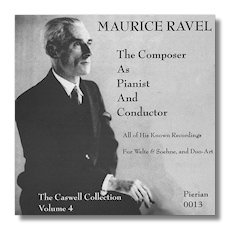
The Internet's Premier Classical Music Source
Related Links
- Ravel Reviews
- Latest Reviews
- More Reviews
-
By Composer
-
Collections
DVD & Blu-ray
Books
Concert Reviews
Articles/Interviews
Software
Audio
Search Amazon
Recommended Links
Site News
 CD Review
CD Review
Maurice Ravel

The Composer as Pianist and Conductor
- Valses nobles et sentimentales
- Sonatine
- Miroirs ("Oiseaux tristes"; "La Vallée des cloches")
- Pavane pour une Infante défunte
- Boléro *
Maurice Ravel, pianist
* Lamoureux Orchestra/Maurice Ravel
Pierian 13 51:51
Summary for the Busy Executive: Time machine.
More from Pierian's list of composer performances before the age of high fidelity. Thanks to this enterprising label, we can listen to Debussy playing his piano music and accompanying Mary Garden in his songs (Pierian 1), in my opinion one of the most important releases in the history of recorded music. Like most of the releases in this series, the Ravel depends on the Kenneth Caswell collection. Caswell, a music-loving engineer, is hipped on the subject of reproducing pianos (popularly and inaccurately known as "player pianos"). He owns several types, as well as the rolls to go with them, and has gone so far as to take them apart and assemble them again, just to understand the workings.
Remember that acoustic and electrical recording (at least in the early days) left much to be desired as an accurate representation of musical performance. Indeed, one can still argue that the live and recorded versions of the same performance differ significantly, and not merely subjectively. Many great composer-performers refused to go before microphones or giant horns because they felt that the resulting sound did them no justice. But some of them – like Mahler, Debussy, Scriabin, Granados, and Ravel – did make piano rolls.
Many different versions of piano-roll technology competed with one another, from the relatively inflexible and crude system most of us associate today with player pianos to the Rolls-Royce devices of the Welte-Mignon company, which reproduced the minutiae of performer dynamics, pedaling, and touch. The Welte-Mignon system represents to me a triumph of the mechanical age. A middle-ground system, made by Duo-Art, also could give back dynamics, but not from the player at the time of playing. Usually, a technician noted the dynamics as the performer played, then added the dynamics to the roll later.
This CD gives us three sonic images of Ravel: through his Welte-Mignon rolls, his Duo-Art rolls, and through an electrical recording from 1930. From the standpoint of sound alone, the electrical recording distorts the performance the most, despite the excellent efforts of engineer Karl Miller to clean things up. The piano rolls, particularly the Welte-Mignons, sound as if you're looking over the composer's shoulder as he plays.
Despite his deep understanding of the piano and of the orchestra, Ravel never considered himself either a pianist or a conductor. In the wings for a performance as soloist in his G-major concerto, he supposedly remarked to the conductor, "What a pity. Now it will all be ruined." Certainly his piano rolls startle less and reveal less than Debussy's. Debussy's piano playing suggests an entire philosophy of music. You get from Ravel something more straightforward. He plays without schmaltz, even in something like Miroirs's "Vallée des cloches." This shows up to best advantage in his classic reading of the first two movements from the Sonatine, which despite its title shows Ravel at his most elegant and most profound. One curious feature of his pianism is his tendency to "riffle" chords slightly, rather than hit the chord so that all notes sound simultaneously. It seems an easy way to provide both more depth of sound as well as greater singing in the line. This shows up in the Welte-Mignon rolls (Valses nobles et sentimentales and Sonatine, both recorded in 1913).
The Duo-Art rolls, from the Twenties, leave the impression of cleaner playing, although whether this represents a shift in Ravel or a larger granularity in the recording process, I have no idea. The Pavane pour une Infante défunte is competent, but, as with Miroirs's "Oiseaux tristes," even a middling professional pianist will mine more color options from the music than Ravel. On the other hand, "La Vallée des cloches" draws a cohesive reading from the composer, no small feat in a six-minute span based mainly on the church-bell cliché of the descending fourth ("Ding-Dong!").
Ravel's conducting of his Boléro not only bears out his own estimate of his podium abilities, but reminds us that this "lollipop" was once difficult modern music. Ravel has trouble keeping the ensemble together. Soloists run ahead of the steady drummer (TUM, dih-dih-dih TUM, dih-dih-dih-dih-dih-dih-dih-dih-dih TUM). Sections veer out of the rhythmic groove from other sections in the tuttis. The sound doesn't help. Ravel conceived the piece as a giant crescendo and the recording flattens this out. After a certain early point, more instruments come in, but the sound doesn't increase. It so happens I recently listened to a modern account of Boléro from a middling orchestra and conductor, and even here the crescendo was more prominent and the ensemble tighter.
But you wouldn't buy this CD for Boléro anyway. Most would probably go for the latest sonic spectacular, and why not? The score was written to sound marvelous. However, it's always interesting to hear a composer's thoughts on his own work. Ravel concerns himself mainly with the grande ligne, generally free of the schmutz and swooning that pianists sometimes bring to his piano music. The piano music, which can sound lush, here appears cool and chaste. The Sonatine points the way to the Valses nobles et sentimentales, Ma mère l' oye, and the second movement of the G-major concerto. It's the worship of beauty from an elegant mind. Another winner from Pierian.
Copyright © 2008, Steve Schwartz




















